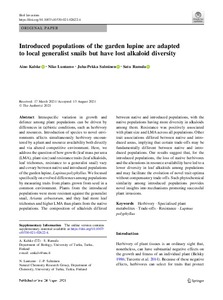Introduced populations of the garden lupine are adapted to local generalist snails but have lost alkaloid diversity
Salminen Juha-Pekka; Luntamo Niko; Ramula Satu; Kalske Aino
Introduced populations of the garden lupine are adapted to local generalist snails but have lost alkaloid diversity
Salminen Juha-Pekka
Luntamo Niko
Ramula Satu
Kalske Aino
Springer
Julkaisun pysyvä osoite on:
https://urn.fi/URN:NBN:fi-fe2021093048468
https://urn.fi/URN:NBN:fi-fe2021093048468
Tiivistelmä
Intraspecific variation in growth and defence among plant populations can be driven by differences in (a)biotic conditions, such as herbivory and resources. Introduction of species to novel environments affects simultaneously herbivory encountered by a plant and resource availability both directly and via altered competitive environment. Here, we address the question of how growth (leaf mass per area (LMA), plant size) and resistance traits (leaf alkaloids, leaf trichomes, resistance to a generalist snail) vary and covary between native and introduced populations of the garden lupine, Lupinus polyphyllus. We focused specifically on evolved differences among populations by measuring traits from plants grown from seed in a common environment. Plants from the introduced populations were more resistant against the generalist snail, Arianta arbustorum, and they had more leaf trichomes and higher LMA than plants from the native populations. The composition of alkaloids differed between native and introduced populations, with the native populations having more diversity in alkaloids among them. Resistance was positively associated with plant size and LMA across all populations. Other trait associations differed between native and introduced areas, implying that certain trade-offs may be fundamentally different between native and introduced populations. Our results suggest that, for the introduced populations, the loss of native herbivores and the alterations in resource availability have led to a lower diversity in leaf alkaloids among populations and may facilitate the evolution of novel trait optima without compensatory trade-offs. Such phytochemical similarity among introduced populations provides novel insights into mechanisms promoting successful plant invasions.
Kokoelmat
- Rinnakkaistallenteet [19207]
